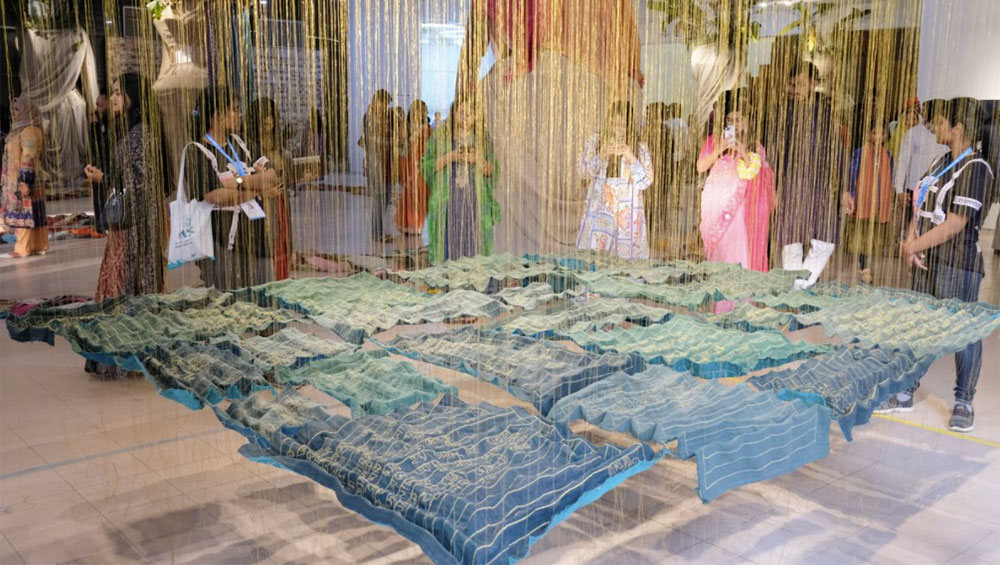
Ashfika Rahman, বেহুলা আজকাল (Behula These Days) (2022–23). Community-led photography and textile installation. Commissioned by Samdani Art Foundation.
Shilpakala Academy, Dhaka, Bangladesh
3 – 11 February 2023
by ALLIE BISWAS
Founded in 2012 by the Samdani Art Foundation, the Dhaka Art Summit (DAS) was initially developed to support artists native to Bangladesh who lacked opportunities to show their work. In a decade, this ambitious enterprise, which takes place over nine days, every other year, has become ensconced within an international network of artists, critics and curators, positioning Bangladesh as a country that is cultivating contemporary art. And people are interested to see it: its last edition, in 2020, took in half a million visitors.
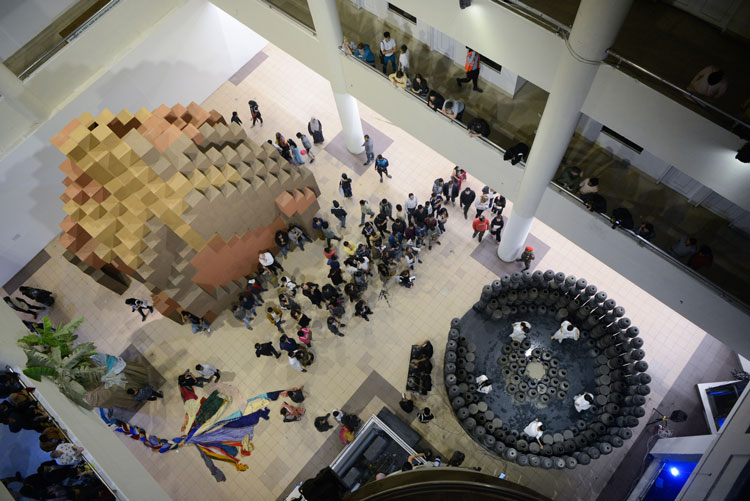
Installation view of the Dhaka Art Summit 2023. Photo: Shadman Sakib. Copyright DAS 2023.
At this year’s event, the presence of locals, whether students, state officials or families, was particularly noticeable. As Dhaka lacks a contemporary art museum, the summit is one of the only platforms where those in the city can be exposed to more experimental practices. Eyes were glued to Matt Copson’s laser animation Age of Coming (2021), which was projected on to the soaring wall that framed the entrance hall of the Shilpakala Academy, where the summit has been held since its inception.
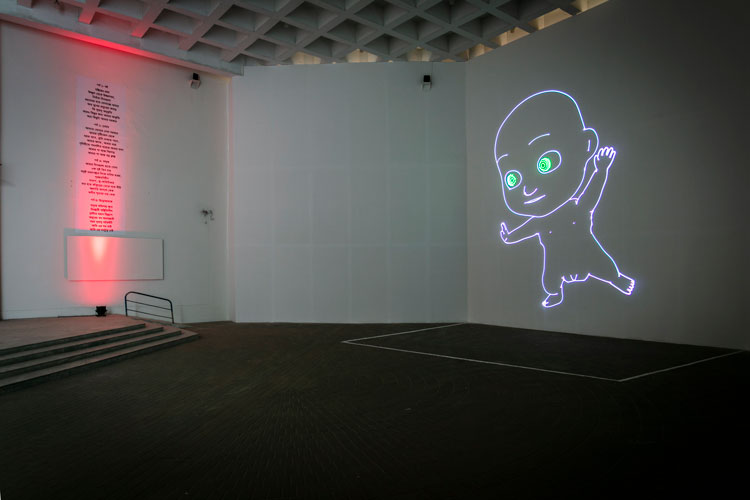
Matt Copson, Coming of Age, 2020. Photo: Farhad Rahman. Copyright Dhaka Art Summit 2023.
In a similar format, the first gallery was dedicated to Lake of Tears (2023), by the Chittagong-based artist Joydeb Roaja, which takes the Kaptai dam on the Karnaphuli River as its starting point. During construction of the dam, by the government of Pakistan in the early 1960s, thousands of acres of land belonging to the Chakma tribe were flooded, resulting in the forceful eviction of about 100,000 people. In his revision of the incident, the artist imagines the community rising from the bottom of the water, bearing the Chakma royal palace in its arms (even the palace was submerged in the floods).
Roaja’s project, which reflects on how a manufactured disaster set out to suppress the country’s indigenous people, informed the framework for the rest of the exhibition, which this year was themed around the notion of “Bonna”. Denoting “flood” in Bengali, while also functioning as a girl’s name, the word’s duality was leaned on as a curatorial thread to explore how climate issues within Bangladesh might be understood. Led by Diana Campbell, who was curating the summit for the fifth time, the theme was unravelled through the imagination of a fictional young girl who contemplates the precarious environment around her. So, while the country may have become synonymous with the calamities of global warming (last year’s flooding in north-east Bangladesh left more than four million people stranded), the artists here instead probed the relationship that Bangladeshis have had with weather and water over time.
In Very Small Feelings, one of five sub-exhibitions in the show, curated by Campbell and Akansha Rastogi, the perspectives of children were brought to the fore in works that revolved around storytelling. A rare 1964 short film by Satyajit Ray, Two, which details a duel between a couple of young boys from completely opposite backgrounds, is a masterclass in power dynamics and materialism.
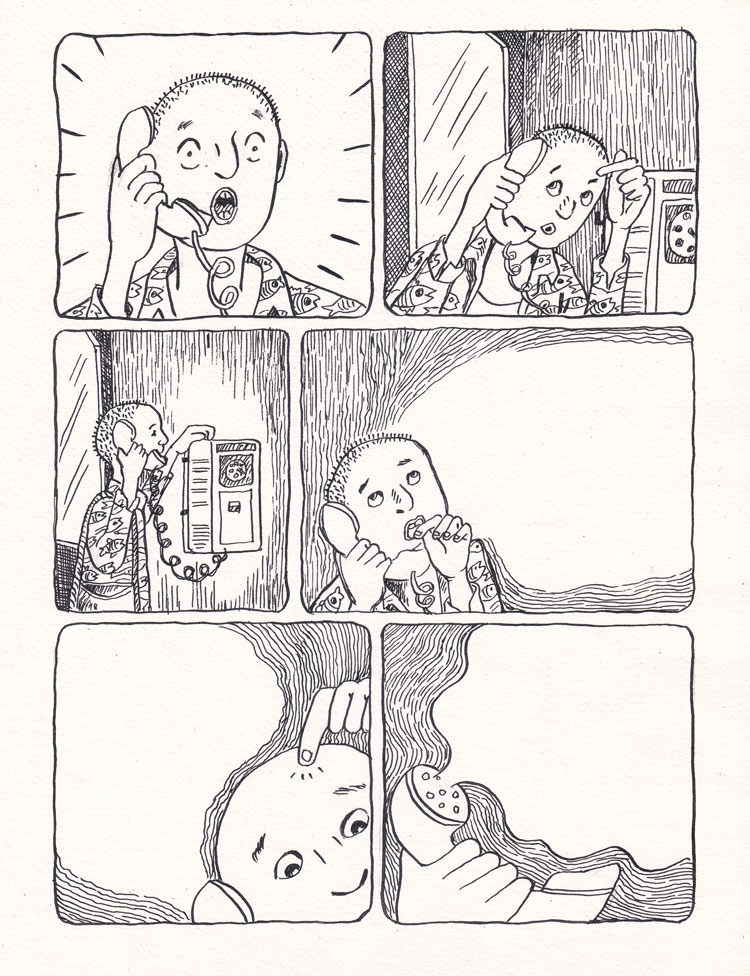
Lokesh Khodke. Selected pages from The Speaking Mountain, co-commissioned by Dhaka Art Summit and Kiran Nadar Museum of Art and Asia Art Archive. Copyright Dhaka Art Summit.
Lokesh Khodke’s presentation similarly highlighted the complex realm within which children operate; one that only magnifies issues that are often considered to exist solely within the world inhabited by adults. The graphic artist displayed a selection of children’s paintings produced in the 1990s taken from the artist Ha Bik Chuen’s archive alongside a label that suggested possible parallels between these scenes and crime reported in the news at the time, namely the street fights taking place in Hong Kong and Macau.
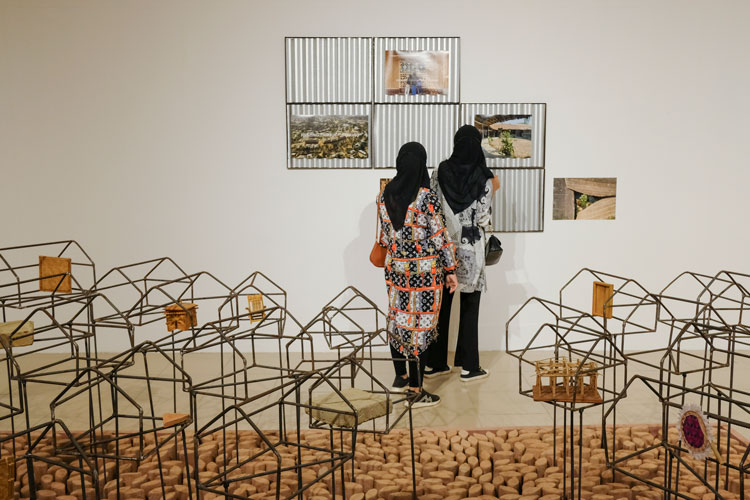
Rizvi Hassan, exhibition view, To Enter the Sky, curated by Sean Anderson. Photo: Shadman Sakib. Copyright Dhaka Art Summit 2023.
Another sub-exhibition, To Enter the Sky, curated by Sean Anderson, questioned how buildings might help to assert a sense of belonging within environments that are continuously in flux. The architect Rizvi Hassan showed photographic and three-dimensional work relating to the temporary community spaces he has built in the Rohingya refugee camps in Cox’s Bazar (which recently won him the Aga Khan Award), bringing to the fore a glaring topical issue. Hassan’s project was a collaboration of sorts with this displaced community, whose knowledge informed the development of his palm leaf and bamboo shelters (the typical Rohingya house, known as the tottar ghor, is crafted from these materials).
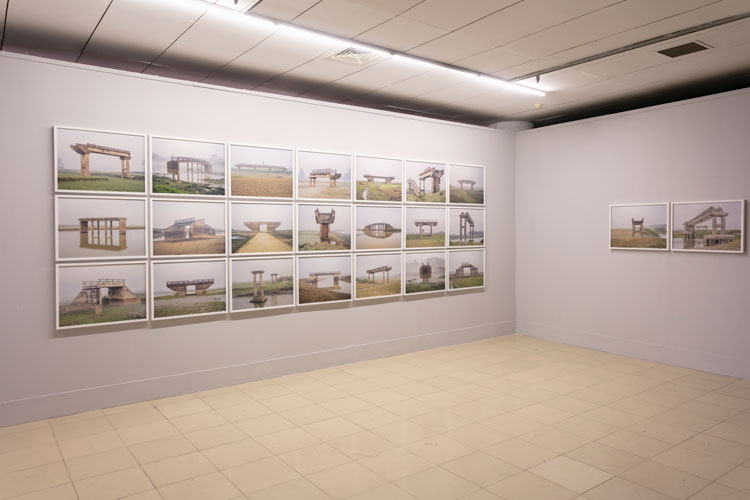
Samdani Art Award winner, Md Fazla Rabbi Fatiq, Photo: Farhad Rahman. Copyright Dhaka Art Summit 2023.
Md Fazla Rabbi Fatiq’s haunting photographs of urban building projects abandoned because of the stinging corruption that pervades the construction industry in Bangladesh (Mirage, 2022-23) also added a critical dimension to an exhibition that overall seemed to steer away from overtly political concerns. These grey-and-green-hued pictures depicted numerous partly built bridges that lie unfinished in open fields and canals – desolate scenes of ruins that run rife across the country. Similarly, Faysal Zaman has brought attention to the phenomenon of “enforced disappearances” within Bangladesh, whereby the government abducts and silences citizens. In (un)filled (2021-23), Zaman uses found images taken from the internet that assert the visibility of these victims.
,-2022-2023.-Community-led-photography-and-textile-installation.-Courtesy-Samdani-Art-Foundation-Photo-by-Farhad-Rahman.jpg)
Ashfika Rahman, বেহুলা আজকাল (Behula These Days) (2022–23). Community-led photography and textile installation. Commissioned by Samdani Art Foundation.
One of the most compelling responses to the “Bonna” theme took the form of Ashfika Rahman’s Behula These Days (2022-23). In this luscious installation, floating green-velvet squares are embroidered with stories of violence endured by women living in one of the most flood-prone areas in Bangladesh – an isolated wetland where the mythological heroine Behula was born. Rahman reframes the protagonist from the popular medieval romance, Behula and Lakhindar, to bring the viewer’s attention to the present-day reality of what it might mean to inhabit the water.